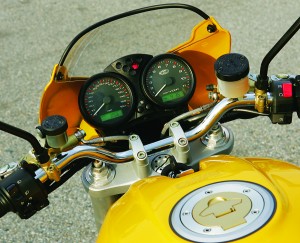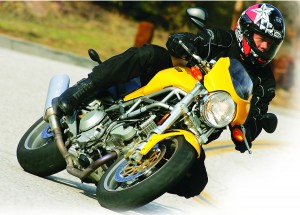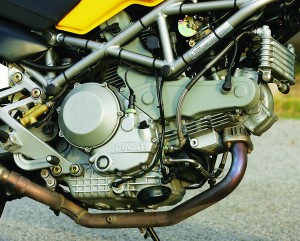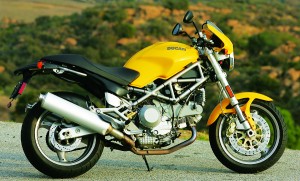Just about every engine that Ducati produces seems to find its way into the tried-and-true Monster series eventually-and that’s a good thing! By coupling the relatively new DS1000 dual-spark engine with the popular and long-running Monster chassis, Ducati produced the Monster 1000 i.e. for 2004, a naked sport-standard V-twin that’s fast, fun and simple.
The Monster M1000 series replaces the 900s and is the most powerful air-cooled Monster yet. For 2004 they were available in two versions. Although both share the same 1,000cc DS (Dual Spark) Desmodue engine previously introduced on the Super Sport series and Multistrada, the basic M1000 i.e. is an essential, stripped-down model while the M1000S i.e. tested here adds a small “flyscreen” fairing and several carbon-fiber goodies to spice it up and add to the street-fighter look.
With a capacity of 992cc the torquey, air-cooled 1000DS Desmodue (pronounced desmo-doo-ay) is a two-valve-per-cylinder engine that offers up sporty performance while maintaining some semblance of simplicity by shunning an added cooling system. The two-valve design also reduces maintenance costs for valve adjustments, which can really add up over the life of a bike-especially a Ducati. Besides simplifying the Monster 1000S and its service requirements, air cooling also eliminates the need for a radiator, which restricts turning radius and makes it difficult to make a U-turn in a narrow street or parking area. By combining Dual Spark ignition, electronic fuel injection with 45mm throttle bodies and an exhaust catalyst, the Monster 1000S has good power yet responsibly low emissions.
The Desmodue engine starts readily warm or cold, yet has the slow cranking-speed characteristic often found on other Ducati models. It’s a little cold-blooded at first and likes to have some fast idle dialed in with the handlebar control for the first mile or so to prevent stalling. It takes about two miles for the oil temperature to begin to register on the digital readout—until then it flashes “Lo.”

On the road, the engine delivers strong, torquey power. Once warmed, throttle response is fairly smooth and linear with just a touch of abruptness off-idle. Grab a handful in first gear, though, and roll-on wheelies will be your companion. Up through the gears, the ’Due pulls strongly from about 4,000 through its redline at 8,500 rpm (which isn’t marked on the tach). When ridden in anger, the engine makes great music and the whole bike seems to work better the harder you ride it. In stop-and-go traffic the engine isn’t happy and tends to buck when forced to lug. We also found that it gets quite hot in summer traffic, with oil temperatures reaching 240 degrees F. on hot days.
Clutch actuation is hydraulic, with an adjustable lever that requires a fair amount of effort to disengage the dry clutch. It’s a little grabby at the launch but works fine after that and is fairly quiet. Shifting is typical Ducati, effective but with a little more lever effort and travel than typical Japanese sportbikes. Gearing is tall from first through sixth; the long-legged top ratio is great for high-speed jaunts with a relaxed gait, although first gear is a bit high in traffic.

On Barnett’s Dynojet dynamometer the DS1000 engine ground out 86.8 rear-wheel horsepower at 8,000 rpm and 65.5 lb-ft of torque at six grand. The torque graph is quite flat, with roughly 50 lb-ft or more from 3,000 through redline.
The 1000 and 1000S share most chassis components. Both models use Ducati’s conventional tubular-steel trestle frame derived from the Sport Touring series to hold everything together. Ride-height adjustment at the rear of the bikes allows riders to tailor the steering to their riding style and road conditions, and both M1000 models share 43mm male-slider forks and single-shock rising-rate rear suspension. On the 1000S, suspension front and rear is fully adjustable.
Good-looking and functional braided stainless-steel/Teflon lines run from the hydraulic clutch and front brake master cylinders. The aluminum swingarm on the Monster 1000S lowers the bike’s overall poundage and reduces unsprung weight, which helps the bike’s suspension compliance on rough, bumpy roads, and improves both stability and handling. After changing a few suspension settings on the 1000S, we were able to get a sporty yet sufficiently compliant ride. With its Michelin Pilot Road tires, the Monster had plenty of grip wet or dry, tracked nicely and showed good tread life. The bike feels light and nimble, turns in sharply, holds a line well and has loads of available lean angle. It feels a little twitchy in bumpy corners and at high speeds due to its short wheelbase and long handlebar leverage, but always seems stable and planted enough to be safe and confidence-inspiring.

Braking force from the front is strong and fade-free. Those large 320mm front platters and four-pot Brembo calipers allow powerful stops from all speeds with just a light squeeze of the adjustable handlebar lever. However, from the time we got the bike (with about 300 miles on it) the front brake chattered annoyingly, perhaps from improper break-in. Like other Ducatis we’ve tested, the rear brake is quite numb and requires high effort to get much stopping power from it, but won’t lock up inadvertently.
Riding position is quite natural and comfortable, mostly upright with a slight forward lean, but tall riders may feel a bit cramped. Although the rider’s seat is quite thin, it distributes weight well and is fine for everyday jaunts. Pillion accommodations are crowded and the saddle slopes toward the back, which won’t make you popular with your passenger if you gas it when they aren’t ready.
The instrument binnacle is located high enough that it’s in the rider’s line of sight, even with a full-face helmet. Both the speedometer and tach are analog and easy to read, as are the indicator lamps. There’s a single tripmeter in the speedo and the tach incorporates a choice of a digital oil-temperature readout or a clock; the rider can toggle between them. Ridden in a spirited manner, the Duc runs low on fuel at around 100 miles, but typically the low-fuel lamp started blinking around 110-120 miles. Fuel economy ranged from 40.4 mpg up to 43.0, with an average of 41.8 overall. Using that average, range to empty works out to 150 miles. Although fuel mileage is good, we’d like to have a little more capacity for greater range.

The ignition and steering-head lock are integrated and incorporate an anti-theft immobilizer system that warns off would-be rustlers with a blinking LED warning. We like the location of the ignition switch, but if you wait too long to push the starter button the immobilizer prevents the bike from starting. Newly designed rear-view mirrors provide improved visibility aft, but shake noticeably, especially when the engine is lugged a bit. Wind protection from the flyscreen is marginal, but helps cut the blast to your torso.
Ducati’s “naked” Monster series is now available in seven different versions with a selection of four different engines in the United States market. For 2004, Ducati introduced the top-of-the-line Monster S4R and we’d be remiss if we didn’t at least mention it here. The S4R’s liquid-cooled, Desmoquattro 996cc powerplant is rated at 113 horsepower. It can be easily identified by its double-stacked, right-side exhausts and an aluminum tubular single-sided swingarm, lots of carbon-fiber bits and a trick Showa fork and rear shock. For 2005 the S2R makes its appearance with the upswept exhaust and some of the S4R’s other bits, but is powered by the 800cc version of the Desmodue engine, so it has sporty looks with more moderate power.
Thanks to their exposed engines, frames and minimalist bodywork combined with sportbike power and handling, the Monster series has been very popular. After living with this 1000S i.e. for several months, we’ve gotten to know it quite well, both the good and not so good. During that time we had several minor problems. As mentioned previously, from the beginning the front brake chattered. At about 1,000 miles, the starter stuck on even with the key removed and the kill switch off, requiring a frantic disconnect of the battery. Later, a rear fender bolt fell out, a mirror came loose and finally the clutch master cylinder cap fell off.

With that said, the Monster 1000S still delivers a nice blend of Ducati character and performance along with a more comfortable riding posture and low seat height favored by many riders. The bike is fast and fun to fling through the corners or fly down the freeway, looks good—and Ducatis hold their value quite well. For 2005, the 1000S i.e. model is essentially unchanged, but will be designated just M1000S, as the small “i.e.” has been dropped. Cost remains the same at $10,995, but the 2005 models will be available in red or black (the frame will match the tank) with black wheels. Each comes standard with a color-coordinated rear-seat cover. The Monster 1000 Chromo is a limited edition with a chrome tank and black wheels and is the only M1000 offered in the United States for 2005.
2004 Ducati Monster 1000S i.e.
Base Price: $10,995
Warranty: 2 yrs., unltd. miles
Engine
Type: Air-cooled, transverse
90-degree V-twin
Displacement: 992cc
Bore x Stroke: 94.0 x 71.5mm
Compression Ratio: 10.0:1
Valve Train: Desmodromic SOHC, 2 valves per cylinder
Valve Adj. Interval: 6,200 miles
Fuel Delivery: Marelli fuel injection, 45mm throttle bodies
Lubrication System: Wet sump,
4.0-qt. cap.
Transmission: Six speeds,
hydraulically actuated dry clutch
Final Drive: O-ring chain
Electrical
Ignition: Electronic
Charging Output: 405 watts max.
Battery: 12V 10AH
Chassis
Frame: Tubular-steel trestle type
Wheelbase: 56.7 in.
Rake/Trail: 24.0 degrees/4.0 in.
Seat Height: 31.5 in.
Suspension, Front: Showa male-slider w/ 43mm stanchions, fully adjustable
w/ 5.1-in. stroke
Rear: Sachs single shock, adj. for
spring preload, rebound damping and ride height w/ 5.8-in. travel
Brakes, Front: Dual discs w/opposed 4-piston Brembo calipers
Rear: Single disc w/ 2-piston Brembo caliper
Wheels, Front: Cast alloy, 3.50 x 17 in.
Rear: Cast alloy, 5.50 x 17 in.
Tires, Front: 120/70-ZR17
Rear: 180/55-ZR17
Wet Weight: 440 lbs.
Load Capacity: 420 lbs.
GVWR: 860 lbs.
Performance
Fuel Capacity: 3.6 gals., warning
light on last 0.8 gal.
Average mpg: 41.8
Estimated Range: 150 miles
Indicated rpm at 60 mph: 3,400
If you’re interested in the 2004 Ducati Monster M1000, you may also be interested in Rider‘s 2005 Ducati Monster 1000S i.e. Review.








